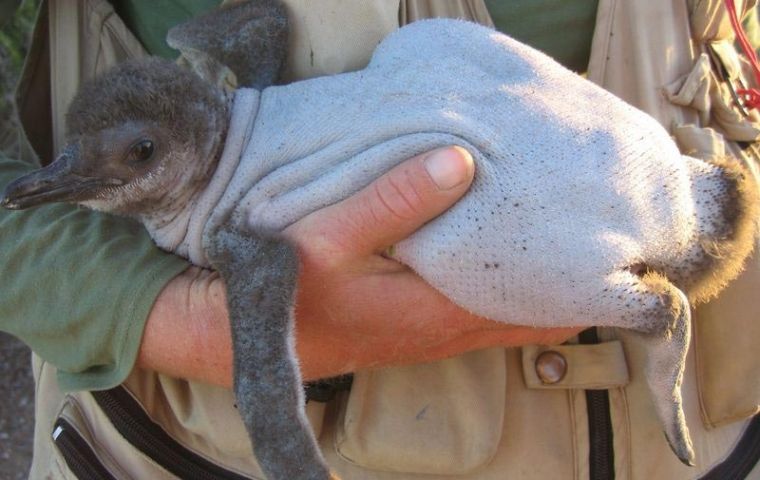MercoPress. South Atlantic News Agency
“Naked” penguin chicks in Argentina and South Africa puzzle scientists
 A researcher holding a featherless Magellanic penguin chick. (Photo by Jeffrey Smith)
A researcher holding a featherless Magellanic penguin chick. (Photo by Jeffrey Smith) Researchers from the Wildlife Conservation Society, the University of Washington, and other groups are grappling with a wildlife mystery: Why are some penguin chicks losing their feathers?
The appearance of “naked” penguins—afflicted with what is known as feather-loss disorder—in penguin colonies on both sides of the South Atlantic, (Argentina and South Africa) in recent years has scientists puzzled as to what could be causing the condition.
A study on the disorder appears in a recent edition of the journal Waterbirds. The authors of the paper are: Olivia J. Kane, Jeffrey R. Smith, and P. Dee Boersma of the Wildlife Conservation Society and the University of Washington; Nola J. Parsons and Vanessa Strauss of the South African Foundation for the Conservation of Coastal Birds; and Pablo Garcia-Borboroglu and Cecilia Villanueva of Centro Nacional Patagónico.
“Feather-loss disorders are uncommon in most bird species, and we need to conduct further study to determine the cause of the disorder and if this is in fact spreading to other penguin species,” said Boersma, who has conducted studies on Magellanic penguins for more than three decades.
The feather-loss disorder first emerged in Cape Town, South Africa in 2006, when researchers for the South African Foundation for the Conservation of Coastal Birds (SANCCOB) first observed the disorder in African (or black-footed) penguins in a rehabilitation centre.
During that year, approximately 59% of the penguin chicks at the facility lost their feathers, followed by 97 of the chicks at the facility in 2007, and 20 of the chicks in 2008. Chicks with feather-loss disorder, it was discovered, took longer to grow to a size deemed suitable for release into the wild. The chicks eventually began growing new feathers.
On the other side of the South Atlantic, Punta Tombo, Argentine Patagonia, researchers from WCS and the University of Washington observed feather-loss disorder in the chicks of wild Magellanic penguins (closely related to African penguins) for the first time in 2007 in four different study sites along Argentina's coastline. Researchers also noted that while feathered chicks sought out shade in the hot midday sun, featherless chicks remained in the sun's glare. Several of the chicks with feather-loss disorder died during the study.
In both instances, penguin chicks with feather-loss disorder grew more slowly than feathered chicks. Featherless chicks were also smaller in size and weight than feathered chicks; both disparities were due to the increased energy spent in thermoregulation in the absence of an insulating coat of feathers and/or down. So far, the possible causes include pathogens, thyroid disorders, nutrient imbalances, or genetics.
“The recent emergence of feather-loss disorder in wild bird populations suggests that the disorder is something new,” said Mariana Varese, Acting Director of WCS's Latin America and Caribbean Program. “More study of this malady can help identify the root cause, which in turn will help illuminate possible solutions.”
“We need to learn how to stop the spread of feather-loss disorder, as penguins already have problems with oil pollution and climate variation,” said Boersma. “It's important to keep disease from being added to the list of threats they face.”




Top Comments
Disclaimer & comment rules-

-

-

Read all comments“Why are some penguin chicks losing their feathers?”
Apr 08th, 2011 - 10:16 pm 0It may be because of the cleanliness of waters, especially now that Japan is making great efforts to achieve goals of more pure and clean waters.
But that would only work if there was a northerly ocean current from Japan.
Apr 09th, 2011 - 04:09 pm 0There isn't. Whatever has gone into the water, assuming it doesn't sink to the bottom, will be heading east. Next stop California...
“But that would only work if there was a northerly ocean current from Japan.” Do you mean that this is like in mathematics, 2 + 2 = 4? Don't be that innocent.
Apr 09th, 2011 - 04:54 pm 0Commenting for this story is now closed.
If you have a Facebook account, become a fan and comment on our Facebook Page!